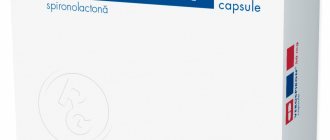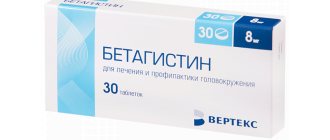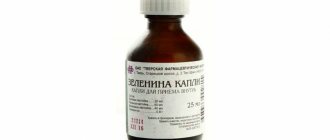Anaprilin is the first developed representative of the group of beta-blockers, the action of which is aimed at stabilizing blood pressure levels. Based on the drug intake, specialists can judge the effectiveness of new medications of this class. As a rule, patients take Anaprilin for blood pressure, but the drug has an additional antiarrhythmic effect, helping to normalize cardiac activity in people with vascular disorders. At what pressure levels can you take the drug and how to dose it correctly to avoid negative effects?
Pharmacodynamics and pharmacokinetics
The main active ingredient is propranolol . Anaprilin is a non-selective adrenergic blocker, reduces the sympathetic effect on beta-adrenergic receptors of the heart, reduces the frequency and strength of heart contractions, reduces the contractile function of the myocardium, regulates cardiac output downwards, blocks the positive inotropic and chronotropic effect of catecholamines, reduces the heart's need for oxygen, reduces arterial pressure. The mechanism of action of the drug is aimed at increasing bronchial tone through blockade of beta2-adrenergic receptors. Anaprilin increases the contractility of the uterus, reduces the risk of bleeding during childbirth, the postpartum and postoperative periods.
When taken orally, the drug is quickly absorbed and excreted from the body. The maximum peak content of the active substance in the blood plasma is recorded after 1 -1.5 hours. The drug penetrates the fetoplacental barrier.
General characteristics of the product
Anaprilin for blood pressure belongs to the group of non-selective beta-adrenergic receptor blockers. The medicine has antiarrhythmic, hypotensive, antiangial properties, due to which it effectively lowers blood pressure without placing additional stress on the myocardium.
After taking a single dose of the drug, a decrease in systolic and diastolic pressure is observed, both in horizontal and vertical positions
Regular use of the medication allows you to achieve the following results:
- reduce the automaticity of the sinus node;
- reduce the excitability of the heart muscle;
- prevent the occurrence of ectopic contractions;
- normalizes the frequency of contractions of the heart muscle;
- inhibits atrioventricular conduction;
- reduces the oxygen demand of cardiomyocytes.
By blocking adrenergic receptors, anaprilin reduces blood pressure in hypertension resulting from disruption of the endocrine and excretory systems (essential and renal hypertension).
Indications for use of Anaprilin tablets
What does the drug help with?
Indications for the use of Anaprilin are: arterial hypertension , sinus tachycardia , angina pectoris, supraventricular tachycardia, unstable angina, atrial fibrillation (tachysystolic form), prevention of migraine attacks, sympathoadrenal crises, NCD. For arterial hypertension, the drug is effective in the initial stages of the disease, and therefore is used more often in young people (under 40 years of age). A decrease in systolic pressure is accompanied by a decrease in heart rate, a decrease in cardiac output and stroke volume. For coronary heart disease, taking the drug reduces the number of angina and increases resistance to physical activity. Particularly effective for concomitant arterial hypertension and arrhythmias.
Anaprilin
Beta blockers should not be used in patients with untreated chronic heart failure until the condition has been stabilized.
Before using the drug, patients with heart failure (early stages) must use cardiac glycosides and/or diuretics.
Monitoring of patients taking the drug should include monitoring heart rate and blood pressure (daily at the beginning of treatment, then once every 3-4 months), recording an electrocardiogram.
In elderly patients, it is recommended to monitor renal function (once every 4-5 months).
In case of increasing bradycardia (less than 60 beats/min), arterial hypotension (systolic blood pressure less than 100 mm Hg), atrioventricular block, bronchospasm, ventricular arrhythmias, severe liver and/or kidney dysfunction in elderly patients, it is necessary reduce the dose of the drug or stop treatment.
The drug should be used with caution in patients with first degree atrioventricular block.
The patient should be trained in the method of calculating heart rate and instructed about the need for medical consultation if the heart rate is less than 60 beats/min.
It is recommended to discontinue therapy if depression caused by taking beta-blockers develops.
Patients who use contact lenses should take into account that during treatment with beta-blockers, there may be a decrease in the production of tear fluid.
Treatment of coronary heart disease and persistent arterial hypertension should be long-term - taking the drug is possible for several years.
Discontinuation of treatment is carried out gradually, under the supervision of a physician: abrupt withdrawal can dramatically increase myocardial ischemia, anginal syndrome, and worsen exercise tolerance. Cancellation is carried out gradually, reducing the dose by 25% every 3-4 days for 2 weeks or more.
When deciding on the use of the drug Anaprilin in patients with psoriasis, one should carefully weigh the expected benefits and the possible risk of exacerbation of psoriasis.
In thyrotoxicosis, propranolol may mask certain clinical signs of thyroid hyperfunction (for example, tachycardia). Abrupt withdrawal in patients with hyperthyroidism is contraindicated as it can worsen symptoms.
Isolated reports of myasthenia gravis have been reported during propranolol therapy. If muscle weakness occurs, consult a doctor. In patients with diabetes mellitus, the drug is used under the control of blood glucose concentration (once every 4-5 months). Use with caution simultaneously with hypoglycemic agents, since hypoglycemia may develop during prolonged breaks in food intake, as well as during insulin therapy. Moreover, its symptoms such as tachycardia or tremor will be masked due to the action of the drug. The patient should be instructed that the main symptom of hypoglycemia during treatment with the drug is increased sweating. There is also a risk of hyperglycemia when taking oral hypoglycemic agents.
When taking clonidine concomitantly, it can be discontinued only a few days after propranolol is discontinued.
For pheochromocytoma, it is used only in combination with alpha-blockers. Do not use simultaneously with antipsychotic drugs (neuroleptics) and tranquilizers.
Beta blockers may increase sensitivity to allergens and the severity of anaphylactic reactions. Propranolol may cause severe reactions to a number of allergens when administered to patients with a history of severe anaphylactic reactions to these allergens. These patients may not respond to the usual doses of epinephrine (adrenaline) used to treat anaphylactic shock.
Drugs that reduce catecholamine reserves (for example, reserpine) may enhance the effect of beta-blockers, so patients taking combinations of drugs should be under constant medical supervision to detect arterial hypotension and bradycardia.
During treatment with propranolol, intravenous administration of verapamil and diltiazem should be avoided.
Use with caution in combination with psychotropic drugs, for example, MAO inhibitors, when used for a course of more than 2 weeks.
A few days before general anesthesia with chloroform or ether, it is necessary to stop taking the drug (increased risk of depression of myocardial function and the development of arterial hypotension). It is necessary to warn the anesthesiologist that the patient is taking propranolol.
In smokers, the effectiveness of beta-blockers is lower.
The drug should be discontinued before testing the content of catecholamines, normetanephrine and vanillinmandelic acid in the blood and urine; antinuclear antibody titers.
Therapy with the drug should be suspended if there is a respiratory infection of the lower respiratory tract accompanied by difficulty breathing. The use of beta2-agonists and inhaled glucocorticosteroids is allowed. Resumption of use of the drug is possible only after the patient has completely recovered. In case of repeated infection, as well as in the case of isolated bronchospasm, the use of the drug should be stopped completely.
It is not recommended to drink alcohol during treatment (a sharp decrease in blood pressure is possible). Beta-blockers should be used with caution in patients with peripheral circulatory disorders, as these symptoms may worsen.
Avoid using natural licorice during treatment; Protein-rich foods can increase bioavailability.
Propranolol may give a positive result in a doping test.
Contraindications
Anaprilin is not prescribed for arterial hypotension , intolerance to components, heart failure, atrioventricular block, sinus bradycardia , sinoatrial block , diabetes mellitus, acute myocardial infarction, bronchial asthma, obliterating vascular diseases, metabolic acidosis , tendency to bronchospasm, vasomotor rhinitis , during pregnancy, breast nom breastfeeding
Side effects
Bradycardia , atrioventricular block, bronchiolospasm, the development of Raynaud's syndrome , heart failure, vomiting, muscle weakness , epigastric pain, vomiting, diarrhea , itching , depression , hypoglycemia - of diabetes are noted. diabetes , visual impairment, decreased potency.
Anaprilin tablets, instructions for use (Method and dosage)
The initial dosage of the drug for arterial hypertension is 40 mg, twice a day. No more than 320 mg per day.
For heart rhythm disturbances, angina pectoris: 20 mg three times a day with a gradual increase in dose to 120 mg in 2-3 doses.
How to take for migraine prevention and essential tremor? First, 20 mg of the drug is prescribed 2-3 times a day, then the dose can be increased to 160 mg.
According to the instructions for use of Anaprilin for pathology of the renal system, dosage adjustment is not required.
Composition and release forms
Anti-pressure tablets Anaprilin are available in dosages of the active substance in concentrations of 10 and 40 mg. To date, an injection form of the product has been developed, which is available in ampoules of 0.25%.
The medication is available in a plastic jar, which can contain 10, 40, 50, 60, 100 tablets.
The active substance in the drug is propranolol hydrochloride, which is used to lower blood pressure levels. The composition also includes additional components:
- microcrystalline cellulose;
- calcium stearate;
- talc;
- corn starch;
- colloidal silicon dioxide;
- hypromellose.
A wide range of dosages of tablet forms of the drug makes it possible for patients to select the required amount depending on the prescribed dosage regimen.
Interaction
Anaprilin mutually enhances the negative effects of diltiazem and verpamil on the myocardium, inhibits the elimination of lidocaine, and prolongs the duration of action of non-polarizing muscle relaxants . The hypotensive effect is weakened when taken simultaneously with glucocorticosteroids , estrogens, and NSAIDs. The hypotensive effect is enhanced by the use of nitrates. Antacids and heparin reduce the concentration of the drug in the blood, phenothiazines and cimetidine increase it. Concomitant use with MAO inhibitors . Anaprilin increases the concentration of theophylline in plasma and slows down its metabolism.
Mechanism of action in hypertension
Before starting a therapeutic course, patients are interested in the question of the effectiveness of the prescribed medication, and does it reduce blood pressure at high levels?
The hypotensive mechanism of action of this drug is due to its ability to block beta-adrenergic receptors of the myocardium and other tissues, which is an integral part of lowering blood pressure. Inhibition of renin production contributes to decreased secretion of angiotensin 2, which leads to a decrease in blood pressure and determines the effectiveness of the antihypertensive effect of pills.
Mechanism of action of the drug for hypertension
The vasodilating effect of Anaprilin is based on the following mechanisms:
- impact on vascular receptors;
- pronounced adrenergic blocking activity;
- increases the release of nitric oxide from endothelial cells;
- expansion of the vascular lumen;
- increased production of vasodilating factors (prostaglandins, prostacyclins);
- decreased production of norepinephrine by sympathetic nerve fibers;
- decreased permeability of blood vessels to potassium and sodium ions.
special instructions
Taking the drug together with tranquilizers and antipsychotics . During long-term treatment with Anaprilin, it is recommended to simultaneously take cardiac glycosides . Discontinuation of the drug should be carried out gradually to prevent the development of acute myocardial ischemia or bronchospasm. For arrhythmias, the beta-blocker Anaprilin helps normalize sinus rhythm, transition atrial fibrillation from tachysystolic to bradysystolic and reduce subjective interruptions in the heart. Possible inhibition of reaction and attention, which must be taken into account when prescribing the drug to drivers, operators and people of similar professions.
Recipe in Latin: Rp.: Anaprilini 0.01 D. td N 20 in tabul. S.
Features of drug cancellation
If it is necessary to take a break from treatment with Anaprilin, the dose should be reduced gradually until complete withdrawal, since abrupt cessation of use of the drug can cause withdrawal syndrome.
Abrupt refusal to take medication can cause an attack of angina, tachycardia and increased blood pressure
Experts recommend discontinuing the use of the medication in the following cases:
- Reducing the number of heart contractions to 50 beats/min.
- At low pressure, when systolic blood pressure drops to 100 mm. rt. Art.
- Development of bronchial spasm.
- Disturbance in the functioning of the liver excretory system.
- Depressive state.
- Ventricular arrhythmia.
The optimal withdrawal period is considered to be 14 days from the moment the patient reduces the dosage until the patient completely stops using the tablets. As a rule, the dose is reduced by 10–40 mg every 6–7 days.
Anaprilin price, where to buy
The price of Anaprilin tablets is 10 rubles per pack of 30 pieces of 40 mg.
You can buy a package of 50 pieces of 10 mg for 20 rubles.
- Online pharmacies in RussiaRussia
- Online pharmacies in UkraineUkraine
- Online pharmacies in KazakhstanKazakhstan
LuxPharma* special offer
- Anaprilin (Anaprilin 40mg) tablet 40mg 50pcs
1480 RUR order - Anaprilin tablets 10 mg No. 50
1100 rub. order
ZdravCity
- Anaprilin tab. 40 mg No. 50Biosintez JSC
30 rub. order
- Anaprilin tab. 0.04g 50pcs LLC FC Zdorovye
61 rub. order
- Anaprilin tablets 10 mg 50 pcs. Biosynthesis OJSC
22 RUR order
- Anaprilin tab. 10 mg n50AO Tatkhimfarmpreparaty
19 rub. order
Pharmacy Dialogue
- Anaprilin (tab. 40 mg No. 50) Biosynthesis OJSC
27 RUR order
- Anaprilin (tab. 40 mg No. 112)Update of PFC JSC
77 RUR order
- Anaprilin (tab. 10 mg No. 50) TCPP
17 RUR order
- Anaprilin (tab. 10 mg No. 112)Update of PFC ZAO
51 RUR order
- Anaprilin (tab. 10 mg No. 50) TCPP JSC
19 rub. order
show more
PaniPharmacy
- Anaprilin tablets Anaprilin tablets 0.04g No. 50 Ukraine, Health LLC
50 UAH. order - Anaprilin tablets Anaprilin tablets 0.01g No. 50 Ukraine, Health LLC
39 UAH order
show more



